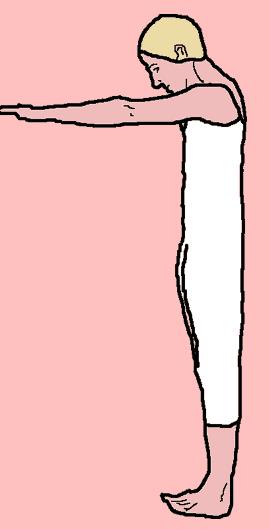Romberg's test
(Redirected from Romberg's sign)
The Romberg's test, also known as Romberg's sign or the Romberg maneuver, is a commonly used clinical examination to assess neurological function, particularly balance and proprioception. In certain situations, it is also used to evaluate suspected impairment due to alcohol or other intoxicants.
The Premise of the Romberg's Test[edit | edit source]
Romberg's test operates on the premise that maintaining balance while standing requires at least two of the three following sensory inputs:
- Proprioception: This is the sense of body position, enabling an individual to perceive the location of different body parts in relation to each other and to the environment without relying on vision.
- Vestibular function: This refers to the inner ear system that provides information about head position and movement, as well as spatial orientation.
- Vision: Visual input helps monitor and correct body position and movement in relation to the surrounding environment.
Performing the Romberg's Test[edit | edit source]
To perform the Romberg's test, the examiner asks the patient to stand with feet together, arms at their sides, and initially with eyes open. After observing for sway or loss of balance, the patient is then instructed to close their eyes. An increase in sway or a loss of balance upon eye closure is considered a positive Romberg's sign, indicating a loss of proprioception and/or vestibular function.
It is crucial for the examiner to stand close to the patient during the test to ensure safety, as a positive Romberg's sign can result in the patient falling.
Clinical Applications and Interpretations[edit | edit source]
A positive Romberg's sign is typically seen in conditions that affect proprioception, such as peripheral neuropathies (like diabetic neuropathy), and conditions affecting the dorsal columns of the spinal cord, like tabes dorsalis and multiple sclerosis. Vestibular dysfunctions and certain cerebellar disorders can also result in a positive Romberg's sign.
The Romberg's test, however, does not discriminate between these different etiologies, and further diagnostic evaluation is necessary to identify the specific cause.
In the context of assessing driving under the influence, a positive Romberg's test can be suggestive of intoxication, but must be considered in conjunction with other clinical signs and findings.
References[edit | edit source]
- [1] Saravanan, S., & Al-Hashel, J. Y. (2018). Clinical signs in neurology: a primer. Mayo Clinic.
- [2] Hanewinckel, R., Drenthen, J., van Oijen, M., Hofman, A., van Doorn, P. A., & Ikram, M. A. (2016). Prevalence of polyneuropathy in the general middle-aged and elderly population. Neurology, 87(18), 1892-1898.
- [3] Demiryoguran, N. S., Karcioglu, O., Topacoglu, H., Kiyan, S., Ozbay, D., Onur, O., & Demir, O. F. (2006). Efficacy of the Romberg test in the intoxicated ED patient. American Journal of Emergency Medicine, 24(4), 441-445.
Search WikiMD
Ad.Tired of being Overweight? Try W8MD's physician weight loss program.
Semaglutide (Ozempic / Wegovy and Tirzepatide (Mounjaro / Zepbound) available.
Advertise on WikiMD
|
WikiMD's Wellness Encyclopedia |
| Let Food Be Thy Medicine Medicine Thy Food - Hippocrates |
Translate this page: - East Asian
中文,
日本,
한국어,
South Asian
हिन्दी,
தமிழ்,
తెలుగు,
Urdu,
ಕನ್ನಡ,
Southeast Asian
Indonesian,
Vietnamese,
Thai,
မြန်မာဘာသာ,
বাংলা
European
español,
Deutsch,
français,
Greek,
português do Brasil,
polski,
română,
русский,
Nederlands,
norsk,
svenska,
suomi,
Italian
Middle Eastern & African
عربى,
Turkish,
Persian,
Hebrew,
Afrikaans,
isiZulu,
Kiswahili,
Other
Bulgarian,
Hungarian,
Czech,
Swedish,
മലയാളം,
मराठी,
ਪੰਜਾਬੀ,
ગુજરાતી,
Portuguese,
Ukrainian
Medical Disclaimer: WikiMD is not a substitute for professional medical advice. The information on WikiMD is provided as an information resource only, may be incorrect, outdated or misleading, and is not to be used or relied on for any diagnostic or treatment purposes. Please consult your health care provider before making any healthcare decisions or for guidance about a specific medical condition. WikiMD expressly disclaims responsibility, and shall have no liability, for any damages, loss, injury, or liability whatsoever suffered as a result of your reliance on the information contained in this site. By visiting this site you agree to the foregoing terms and conditions, which may from time to time be changed or supplemented by WikiMD. If you do not agree to the foregoing terms and conditions, you should not enter or use this site. See full disclaimer.
Credits:Most images are courtesy of Wikimedia commons, and templates, categories Wikipedia, licensed under CC BY SA or similar.
Contributors: Prab R. Tumpati, MD



